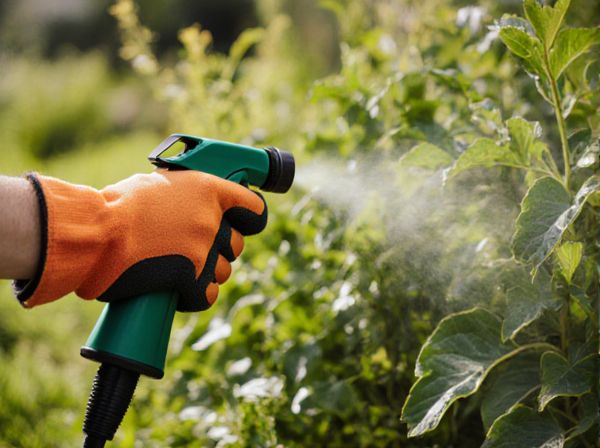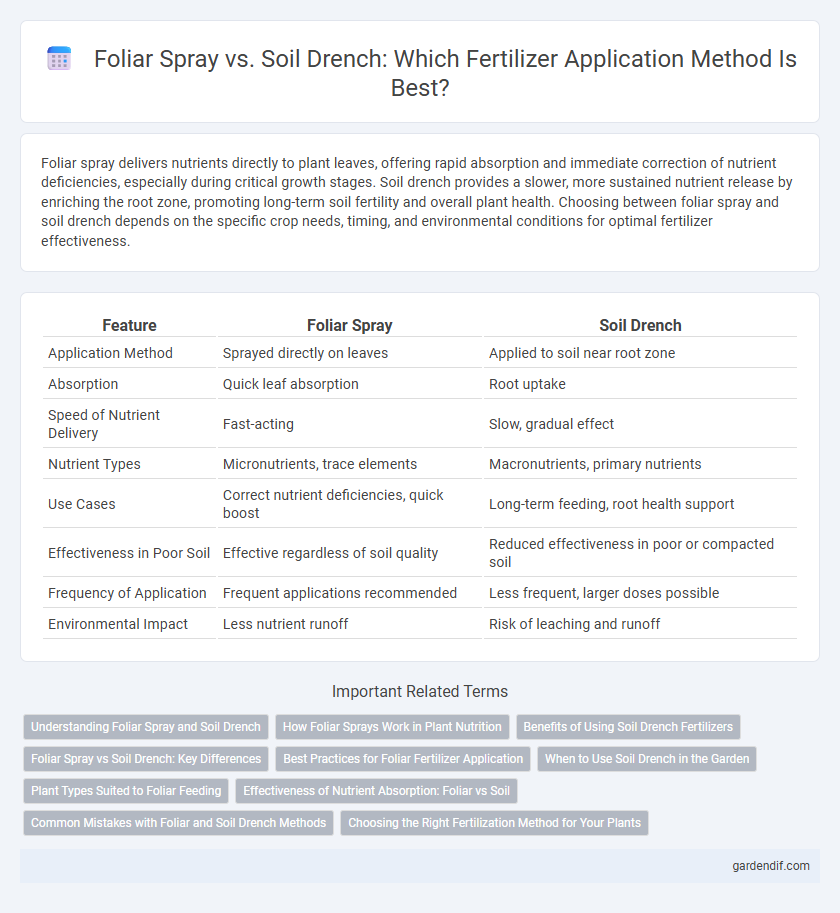
Foliar spray vs soil drench Illustration
Foliar spray delivers nutrients directly to plant leaves, offering rapid absorption and immediate correction of nutrient deficiencies, especially during critical growth stages. Soil drench provides a slower, more sustained nutrient release by enriching the root zone, promoting long-term soil fertility and overall plant health. Choosing between foliar spray and soil drench depends on the specific crop needs, timing, and environmental conditions for optimal fertilizer effectiveness.
Table of Comparison
| Feature | Foliar Spray | Soil Drench |
|---|---|---|
| Application Method | Sprayed directly on leaves | Applied to soil near root zone |
| Absorption | Quick leaf absorption | Root uptake |
| Speed of Nutrient Delivery | Fast-acting | Slow, gradual effect |
| Nutrient Types | Micronutrients, trace elements | Macronutrients, primary nutrients |
| Use Cases | Correct nutrient deficiencies, quick boost | Long-term feeding, root health support |
| Effectiveness in Poor Soil | Effective regardless of soil quality | Reduced effectiveness in poor or compacted soil |
| Frequency of Application | Frequent applications recommended | Less frequent, larger doses possible |
| Environmental Impact | Less nutrient runoff | Risk of leaching and runoff |
Understanding Foliar Spray and Soil Drench
Foliar spray delivers nutrients directly to plant leaves, enabling quick absorption and immediate correction of micronutrient deficiencies, while soil drench applies fertilizers to the root zone, promoting sustained nutrient uptake and improving soil health over time. Foliar application is effective for fast-acting nutrients like iron, manganese, and zinc, whereas soil drench supports macronutrient availability such as nitrogen, phosphorus, and potassium essential for overall plant growth. Understanding the specific nutrient needs and plant growth stages guides the optimal choice between foliar spray and soil drench for maximizing crop yield and quality.
How Foliar Sprays Work in Plant Nutrition
Foliar sprays deliver essential nutrients directly to plant leaves, enabling rapid absorption through stomata and epidermal cells, which enhances nutrient uptake efficiency compared to soil applications. This method bypasses soil-related issues such as nutrient fixation or leaching, providing immediate correction of micronutrient deficiencies like zinc, iron, and manganese. Foliar feeding is particularly effective during critical growth stages to optimize photosynthesis and improve overall crop yield and quality.
Benefits of Using Soil Drench Fertilizers
Soil drench fertilizers provide targeted nutrient delivery directly to the root zone, enhancing nutrient uptake efficiency and promoting robust root development. This method improves soil microbial activity, which supports healthier plant growth and increased resistance to diseases. Unlike foliar sprays, soil drenches offer longer-lasting nutrient availability, reducing the frequency of application and optimizing overall crop yield.
Foliar Spray vs Soil Drench: Key Differences
Foliar spray delivers nutrients directly to plant leaves for rapid absorption, enhancing nutrient efficiency and quicker stress recovery compared to soil drench that targets root uptake. Soil drench improves long-term soil fertility and root development by releasing nutrients gradually but may face limitations due to soil composition and microbial activity. Choosing between foliar spray and soil drench depends on crop type, nutrient requirements, and environmental factors for optimized fertilization strategies.
Best Practices for Foliar Fertilizer Application
Foliar fertilizer application requires precise timing and concentration to optimize nutrient absorption and minimize leaf burn, with typical concentrations ranging from 0.5% to 2% of the nutrient solution. Applying foliar sprays during cooler parts of the day, such as early morning or late afternoon, enhances nutrient uptake and reduces evaporation losses. Thorough coverage of the leaf surface, especially the undersides, ensures effective absorption and maximizes the benefits compared to soil drench methods.
When to Use Soil Drench in the Garden
Soil drench is ideal for delivering nutrients directly to the root zone, especially during the early growth stages or when plants show signs of nutrient deficiency. It ensures deep penetration and long-lasting nutrient availability, making it suitable for heavy feeders and container plants with limited soil volume. Applying soil drench after watering or during cool parts of the day maximizes absorption and minimizes volatilization.
Plant Types Suited to Foliar Feeding
Foliar spray is ideal for fast-absorbing nutrient delivery in fruiting plants, vegetables, and leafy greens that show early signs of nutrient deficiency. It suits high-value crops like tomatoes, peppers, and cucumbers, where quick correction of micronutrient imbalances is critical. In contrast, soil drench targets root absorption, making it more effective for deep-rooted plants and larger trees that require sustained nutrient availability.
Effectiveness of Nutrient Absorption: Foliar vs Soil
Foliar spray delivers nutrients directly to plant leaves, enabling rapid absorption and quicker correction of micronutrient deficiencies compared to soil drench. Soil drenches provide a steady and sustained supply of nutrients through the root system, supporting long-term plant growth and soil health. Effectiveness depends on nutrient type and plant condition, with foliar sprays excelling in immediate nutrient uptake while soil drenches enhance overall nutrient availability.
Common Mistakes with Foliar and Soil Drench Methods
Common mistakes with foliar spray include applying during peak sunlight hours, which can cause leaf burn, and using incorrect concentrations that either damage plants or reduce nutrient absorption. Soil drench errors often involve overwatering, leading to nutrient leaching and root oxygen deprivation, and failure to target the root zone accurately. Proper timing, dilution, and application technique are essential to maximize nutrient uptake and avoid plant stress in both methods.
Choosing the Right Fertilization Method for Your Plants
Foliar spray delivers nutrients directly to plant leaves, enabling rapid absorption and immediate correction of deficiencies, while soil drench enriches the root zone, promoting deep nutrient uptake and sustained growth. Selecting the optimal fertilization method depends on the plant species, growth stage, and specific nutrient requirements, with foliar sprays suited for quick interventions and soil drenches ideal for long-term soil fertility. Understanding these differences ensures efficient nutrient application, maximizing plant health and crop yield.
Foliar spray vs soil drench Infographic

 gardendif.com
gardendif.com